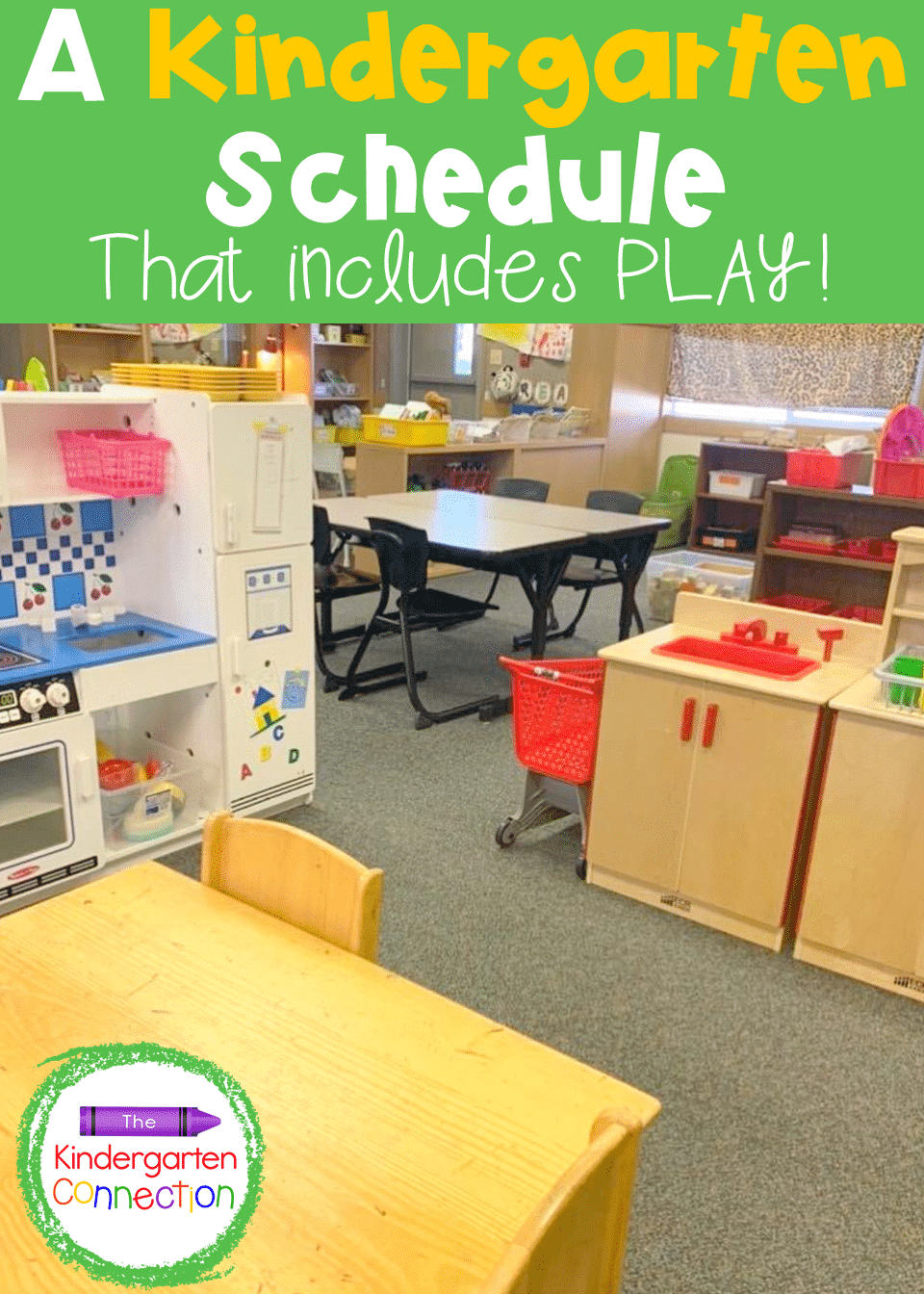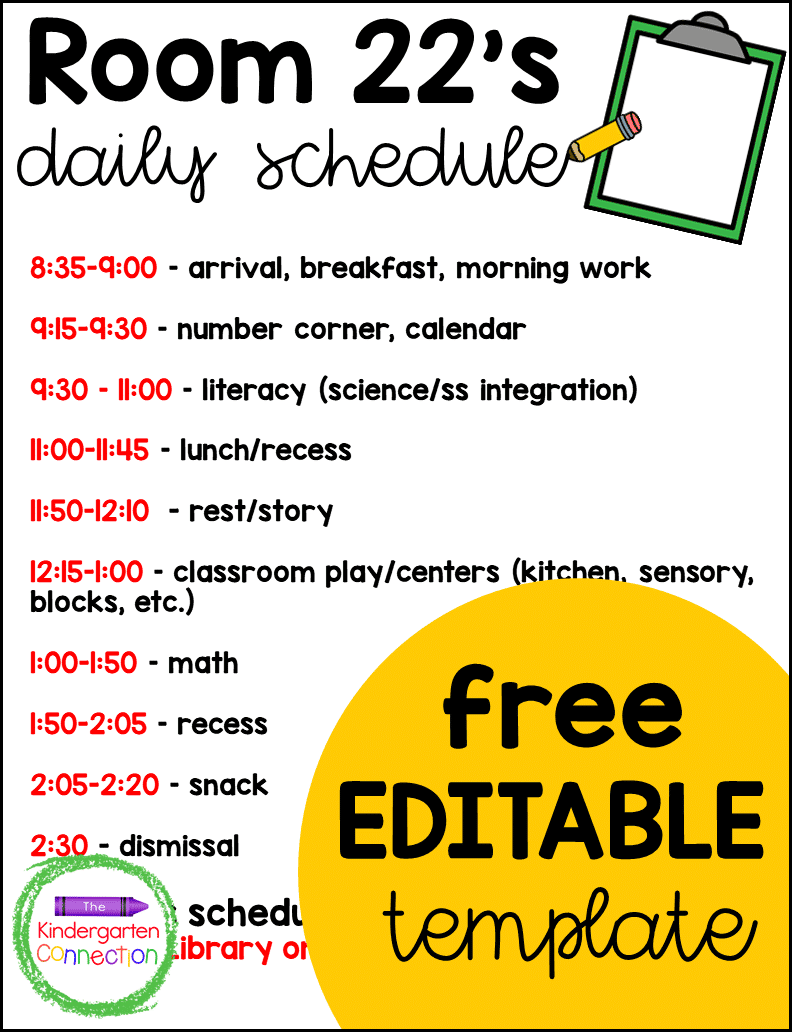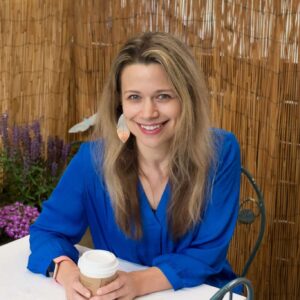I get asked a lot about our Kindergarten schedule from a variety of people. Sometimes parents, other teachers, or even people not in education at all say things like, “When I was in Kindergarten we took naps!” and they are curious about what it looks like today. I even hear, “What do you do all day?” Well, trust me, we are busy! If you have known me for a while or been around this site, you know that I am a huge advocate for play in the classroom. I am very blessed to teach in a place where play is not only supported but a part of every Kindergarten classroom daily. Due to this, I have been asked a lot about how that fits into our day. I thought it would be helpful to share our Kindergarten schedule with you!
*Don’t miss out! For even more teacher support and access to tons of amazing resources, request your invite for our “All Access” Print and Play Club membership!

Before sharing my schedule, I just want to state that every classroom is different in every school around the world. What works for one doesn’t work for another, and schedules often vary based on district requirements, bus scheduling, etc.
I also know that sadly, several Kindergarten teachers are simply not allowed to have play in their classrooms. This is so disheartening, and I hope a change is near for them! If that is the case for you, I suggest reading 10 Ways to Incorporate More Play into Your Classroom. I hope you can find some inspiration!
And be sure to check out this full day Transitional Kindergarten schedule for even more examples of how to include play in the classroom!
My schedule for Kindergarten is just to give you a glimpse into our day since I have been asked so much about it. I am not going into full detail in this post about each aspect of our day. But I hope to answer the main question of “What do we do all day?”
Of course – I would love to hear from you anytime with more questions!
*I currently teach Transitional Kindergarten, however, this schedule is very similar to when I taught Kindergarten (see schedule linked above).
8:35-9:00 – arrival, breakfast, morning work
Our morning work consists of unpacking, signing in, fine motor tasks, and play.
9:15-9:30 – number corner, calendar
I recently made the switch to number corner and calendar in the morning and I LOVE it – I really feel like for my class and preferences, this flows better in the morning vs. later in the day during math.
9:30-11:00 – literacy (science/ss integration)
Our literacy block focuses on mini lessons, writing time, a LOT of reading and read alouds, and free-flowing centers, where students are moving through their choices and I am meeting with small groups.
Want to know more about free-flowing centers? You can learn all about how they work in the P.L.A.Y. course (request your invite!).
11:00-11:45 – lunch/recess
11:50-12:10 – rest/story
We don’t sleep or take naps, but we do spend some time with the lights out just taking it easy with a story/regrouping. These kids are very young and the day is busy!
12:15-1:00 – classroom play/centers (kitchen, sensory, blocks, etc.)
This is when my kids make their plan to play in our classroom. We have a kitchen area, blocks, cars, LEGOS, puzzles, and tons more.
Our room is set up so that our work areas are actually integrated into play areas. You won’t find toys on the outskirts of the room, rather the centers are all throughout and in well defined spaces.
Kids decide on a plan, but are allowed to change their plan and move freely between areas. During this time I support the development of social-emotional skills, as well as work on academics in authentic ways as they come up naturally through play.
For instance, if I have a student who isn’t able to count with one-to-one correspondence, I may build a LEGO tower with him and count the blocks. If a student cannot read CVC words, we may do word puzzles together or read books.
This is a time that they are continually learning and it is SO important for their development. I can’t imagine our day without it!
Keep in mind they are allowed to free play, and I do not interrupt their play. Rather, if they are interested in playing and learning with me, I may approach them, but I never interrupt them.
For instance, if a child was already immersed in building legos, I would never go over there and make them count them. It’s only if we have started building together or they show an interest.
1:00-1:50 – math
Math is a similar structure to literacy. Routine is VERY important at this age and they thrive when they have similar systems in place throughout the day.
We have mini lessons, number talks, and free-flowing math centers (similar to literacy) where students are freely moving through their choices and I am meeting with small groups.
1:50-2:05 – recess
2:05-2:20 – snack
2:30 – dismissal
Note – early in the year we dedicate WAY more time to dismissal and pack up – it takes us a while to get it down to ten minutes. 😉
Need an EDITABLE template to plan your own schedule? I have the one below for you – snag it at the bottom of the post!

I also get asked the following questions (or receive these comments) sometimes –
Don’t you have standards to meet?
Yes, we are actually a Common Core state so we definitely do! I find that my kids are succeeding because this play is intentional and supporting the whole child.
You must have “high kids” if you have time to play…
No, I actually have kids with all abilities and from all sorts of walks of life and backgrounds. Students qualify for Transitional Kindergarten based on social-emotional, cognitive, behavioral, and academic need – so it’s a busy room! Learning through play supports my kids where they are at, so it is differentiation at its finest!
I wish we could do that!
Trust me, I wish that for you too. It is my hope that developmentally appropriate practices will continue to be spoken for and fought for, and that play can be brought back in every room!
You can grab your free editable schedule template by clicking the large, yellow download button at the end of the post (be sure you have PowerPoint to open)!
Your planning will be so much easier with instant access to:
Be sure to request an invitation so that you don’t miss your chance to be part of the best early childhood club around!


Learn how to create a PLAYFUL classroom with our LIVE Path to Play Training. You’ll leave feeling excited and ready to go for next school year so you can enjoy every minute of summer break!
117 Responses
Hello,
I am so intrigued by your schedule. I wish we had the freedom to have a schedule like this.
8:10-8:25 -Breakfast
8:25-8:30- Clean Up/ Bathroom
8:30-9:30- Small groups reading. 3 groups by tier switching between three stations. Para/Intervention Teacher/Teacher
9:30-10:00- Recess
9:45-10:30- Whole Group Reading (no writing to be done, I practice handwriting for 10 min, SHHHH)
10:30-11:15- Split Group – Another small group basically to focus on comprehension and vocab
11:15-11:30- Calendar, I have kind of went away from calendar and focus more on math or do a fun read aloud.
11:40-12:15- Lunch/Recess incorporated with 5 min of zero talking eat time
12:15-12:50- Depending on day specials, science, writing. I try to do at least 2 writing sessions a week and one science at least.
12:50-1:15- same
1:15- 1:50- same
2:00-2:15- Recess
2:15-3:15- Snack, Math- I am a new teacher, Still trying to figure out how to do both whole group instruction and small group instruction during this time. Suggestions welcomed.
We recently went through a grant in which we focused on reading. Many of those practices are still in place. 2 1/2 hours of reading somehow is necessary with very little writing during this time.
I wish we had more choice here in WV. My husband and I are making plans to move to TN by the summer. I am given my schedule and I have to follow it to the tee. They are given recess ONE time,12-1230 and then it’s back to work. I have gotten in trouble multiple times for giving my kids a 15 minute snack/recess break at the end of the day because our specials are in the morning. This makes our afternoons (12:30-3:00) DRAG by.
Our schedule is similar. Our kids do one 45 minute special (Art) in the morning. One 15 minute recess time then from 11:15am to 3:40pm they are in the classroom learning all afternoon. That’s a very long stretch and it is so exhausting. I keep saying there needs to be a special, recess, anything in the afternoon to break up that time.
Hi. It looks like on our classroom we have less structured, more open-ended play. Don’t get me wrong, we have name books and Wonder journals but we have on average 1 1/2 hours of play based learning a day. Kids need long blocks of time for exploration 🙂
Hi Alex, I love your website! And thank you for sharing some of your awesome materials.
It is so encouraging to hear from someone who knows the importance of play. What I am seeing is that younger teachers are being educated without an emphasis on the importance of play. Many begin teaching with no play in the schedule because it was not a part of their training. They don’t know that they can and should include a block for free play. They don’t know that it it CRITICAL because no one is telling them that play is the BEST way that young children learn and grow.
There are also many cases where play has been removed because there is “no room in the schedule”, especially when K teachers must include test prep and testing, oftentimes requiring 1-on-1 administration since to 5 year olds, these paper based tests look like a mess of squiggles and lines. They don’t know what to do with them!
Every single kindergarten schedule in the country should include an hour of free play with housekeeping, lego, puzzles, dress up, etc.In my school, play is “allowed” but it seems some teachers are afraid that it is not really learning, so it’s done quietly. In my classroom, we are not quiet about it! .
Are you aware of the organization called Defending the Early Years? GREAT org – worth taking a look. An article I wrote about Testing in Kindergarten appeared in the Washington Post Education Column. It tells of my very real experience testing my 5 year olds. I posted the link below. Mind boggling, what we are forcing these kids to do.
Again, so encouraging to hear a voice of wisdom regarding play in K. Please use that voice EVERY chance you get. Maybe with enough of us, k classrooms will again become places of creativity, exploration, freedom and adventure vs. paper and pencils, memorization and drills to learn concepts for which a 5 year old is not yet ready.
https://www.washingtonpost.com/news/answer-sheet/wp/2015/09/02/test-prep-for-5-year-olds-is-a-real-thing-heres-what-it-looks-like/?utm_term=.be349bd3baa0
8:45-9:05 unpack/journal writing that consists or writing and math problem
9:05-925-morning meeting& while group math lesson
9:25-955 math centers (play driven)
9:55-10:30 specials
10:30-10:50 snack
10:50-11:15 language arts whole group lesson
11:15–11:45 l/a centers (play driven)
11:45-12:45 RTI- our children change classrooms for this. I teach the highest level. Working on first grade concepts of vowel teams, word families, guided reading, and writing
12:55-1:30 lunch -ITS SO LATE. KIDS ARE STARVING!
1:30-2:00 science/social studies
2:00-2:30 RECESS (indoor or outdoor, depending on weather)
There is a lot of rigor in our day, but we try to incorporate fun as much as we can.
THIS is what I want for my kids. Learning through play. Structured kindergartens here in the US are missing the very basics of how children learn at age 5. There are years and years of structure in school ahead of them, age 5 is too young. They learn math, language and, most importantly, socialization skills naturally. They learn social cues and empathy through playing with the peers. They learn math by counting out rocks they’ve collected. They learn science by seeing what can float in a puddle. The US has is all wrong.
My daily schedule:
8:20- Students arrive, get unpacked and read from their book boxes or morning work.
8:35- Social Stuides
8:40- Oral Language Routine
9:00- Literacy Center #1 and Jan Richardson Guided Reading
9:20- Literacy Center #2 and Jan Richardson Guided Reading
9:40- Interactive Read Aloud
10:00- Literacy Center #3 and Jan Richardson Guided Reading
10:20- Shared Reading and Word Work
10:40- Literacy Center #4 and Jan Richardson Guided Reading
11:00- Explicit Reading
11:20- Explicit Writing
11:44- Lunch
12:14- Science
12:35- Specials
1:20- Core Math Block
2:15- Math Intervention
2:40- Health
3:05- Dismissal
I wish we had play centers and recess. I just know they would benefit from getting to explore without structure. However, I LOVE what I do and couldn’t imagine doing anything else! Kindergarten rocks!
Omg!! I’m always looking for ideas on different schedules! Your schedule is very similar to mine which makes me feel great!! I feel like I’m providing opportunities for students to be engaged and in charge of their learning! I’d love to know what some of your activities consist of during your morning check in! I do workshops, which are all activities related to reading/writing but I may add a math area in there. I had never really thought about doing that before. Would love to hear mor!
Hi!!
I love this schedule and nice to see how much time you spend on each area and how you do so. I would love to learn more about daily 5 and how to actually implement it. We have all the areas but I feel like I usually only get to one rotation a day. Is your writers workshop part of that.. with work on writing in daily 5?
Also, do you not have a calendar time? reading/phonics curriculum time?
Thank you for sharing your day & the inclusion of the importance of play. I teach Prep ( the same as kindergarten) in Melbourne Australia. Our school year is almost complete & we are setting up for next year, our focus is going to be implementing elelments of ‘ Kathy Walker’ play based learning.
Currently my school only use play at the beginning of the school year at the start of the day as a means to transistion our students into school.
Currently the timetable for the day is:
8:50-9 students arrive & set up
9-9:20 independent reading
9:20-9:30 class roll & calendar
9:30-9:40 reading mini lesson
9:40-10 reading activity / guided reading
10:00 Munch & crunch
10:05:10:50Maths
10:50-11 eat snack
11:00-11:30 recess play outside
11:30-12:30 writing
12:30-1:20 Science or Humanaties
1:20- 1:30 eat lunch
1:30-2:30 lunch play outside
2:30-3:15 extra maths or literacy support
3:15 pack up
Share time
3:30 home
3hrs per week are Art, PE & Lote
My team aim to do some shadowing of students ( not interrupting, just observing or if the kids include us) the developmental play will occur after recess & be our driving force into writing. Where our students will use their experiences during play to write.
Thank you so much for sharing your schedule! I love to read others’ schedules, particularly those not in the U.S as well – it is very interesting! (and I have to say I just LOVE how you have your snack time called munch and crunch – that is so fun!!) 🙂
My sister is getting ready to enroll her daughter in kindergarten, but she was curious about full day instead of half. It’s great that they still follow the common core. Since my sister can get really busy, a program like this might be good for her.
Interesting approaches to the FULL-day kindergarten! I teach in an urban school in Britsih Columbia. My typical day starts with children arriving at 8:45. I have provocations/exploration tables et up. The often entire around an inquiry. This week was What happens when circles and patterns meet? I set up materials that allow them to explore the inquiry using loose parts, art materials etc. At 9:15 we usually meet at circle in a friendship circle. We sing a song, or do a pocket chart with an emphasis on rhymes, letters, sight words. We have snack from 10-10:15, outside recess from 10:15-10:30. From 10:30- 12:10 we have a blended play to learn approach ( centres such as blocks, story workshop with close parts, science exploration, light table, sensory able, painting, drama centre etc), We have lunch from 12:10 – 1:02 ( my lunch as well). The afternoon begins with read to self / read with a partner, read with a teacher. We use our afternoon alternately to explore nature outside, explore math concepts, and to explore other inquiry / projects. We end our day with movement songs, yoga, and instrumental play. the children are learning with lots of authentic, structured, intentional teaching and planning, but PLAY is the most important aspect of our day. The day ends at 2:50 and my afternoon continues with prepping and meetings.